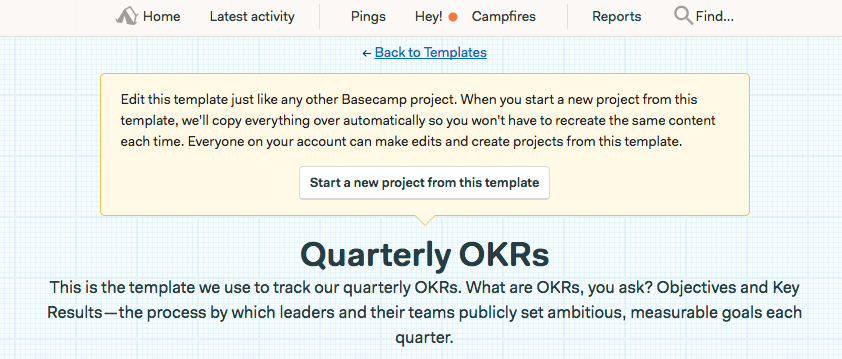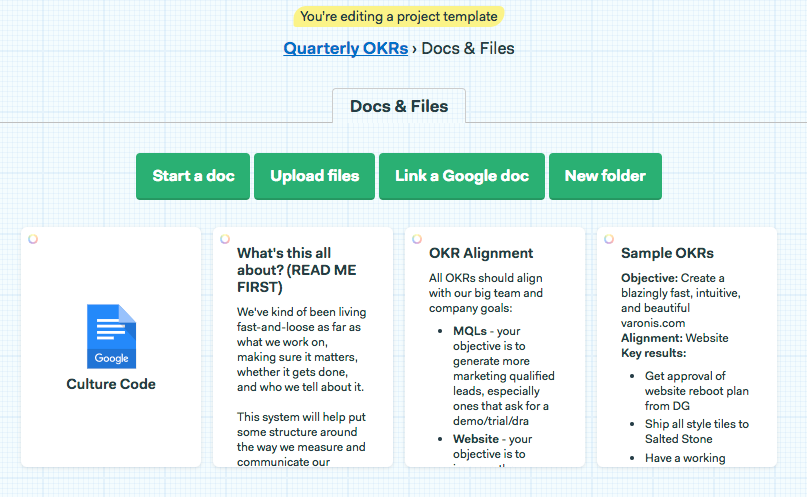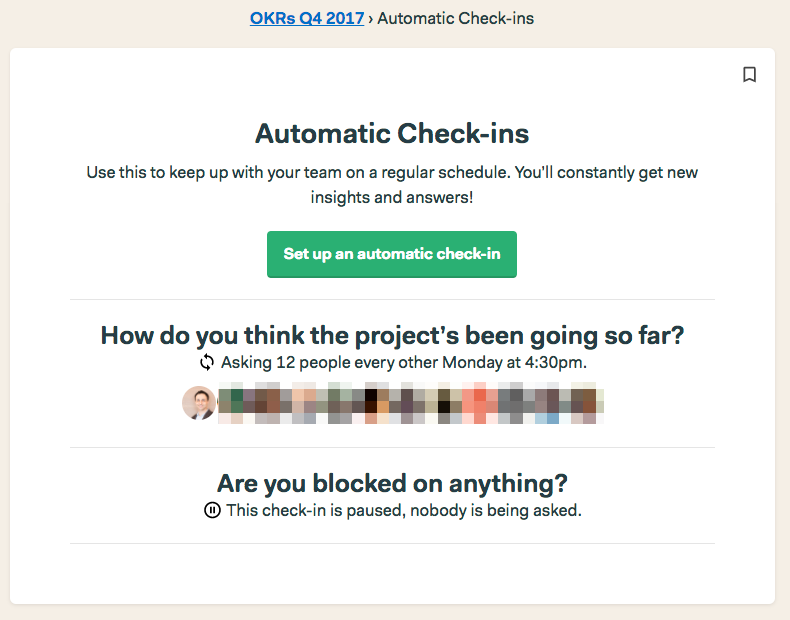Marketing OKR Framework: A Step-by-Step Guide with Examples

A wave of uncertainty washed over me recently.
Is our marketing team working on the right things? If we halt all our current projects, would our KPIs nose-dive?
I feared not.
Then I started seeing a trend in our weekly standup meetings: everyone was being productive, but no one was focused directly on our North Star metric.
GAH! How’d that happen?
There’s a simple explanation: without focus and structure, important loses the daily battle with urgent.
We casually abandoned our system for setting ambitious, measurable goals and staying accountable. I took my hands off the wheel because we were generally doing a fantastic job growing the business.
But growth is a game of inches. What are we leaving on the table by putting the team on cruise control? Would more thoughtful direction yield 2X the results? 20X? 200X?
“You’re smart, go do great work!” isn’t direction. It isn’t teamwork. It’s the approach you take when you get too busy to steer the ship. It’s scattershot. And that’s one hundred percent on me.

Setting Goals with OKRs
I did a lot of research on goal-setting frameworks. Most of the systems I found were far too complicated or didn’t work well for marketing teams. I settled on something that is both lightweight and familiar to me: OKRs.
OKR = Objectives and Key Results. Put simply, it’s a framework for setting ambitious goals and tracking progress.
OKRs were invented at Intel and made popular by John Doerr, early investor and current board member at Google. They’re widely used at high growth companies like Google, LinkedIn, HubSpot, Amazon, Slack, and Netflix.
The framework is very lightweight:
- State your objective
- Make sure it aligns with company goals
- Define three easily measurable key results that signal that you’ve met that objective
That is the guts of it! You could grab a sheet of paper and write down your OKR. Or do it on a whiteboard. Or Trello. It doesn’t really matter, as long as it’s ambitious, aligned, and measurable.
Keep reading and I’ll show you our setup and how we decided what our OKRs should be.
Culture Reset
Before dropping a brand new system for setting and tracking goals, I felt the need to revisit our core values and get everyone on the same page about the type of team we aspire to be.
I’ve seen hundreds of company culture decks, but never took the time to make one. I’d always felt that tacit expectations between high-performing teammates worked well enough. Even if that was the case early on, it certainly isn’t now that we’re a bigger team.
The team has evolved organically over the past six years and our culture and mission is starkly different now, at marketer #11, versus marketing #2. And when we hire marketer #12, this doc will come in handy.
There isn’t a universal right time to codify your team values, but I will say that I wish I’d done it sooner.
Here’s the outcome: My team’s culture doc (clone and use as a template!)
It’s important to note that while I wrote the initial draft, many people on my team edited it, removed sections, added their own, etc. Culture isn’t something you can define and enforce as a leader. It’s something you build together and embody with your daily actions.
The absolute best resource I found during this process was Tettra’s repository of high quality culture decks.
Back to OKRs!
Our Marketing OKR Framework
We use Basecamp 3 for our OKRs (and many other things), but you can use whatever you’d like. The tool doesn’t really matter. A folder in Dropbox or Google Drive will work just fine.
I have a project template in Basecamp called “Quarterly OKRs.” It contains all the basic components (which I’ll describe in a sec).
Each quarter, I simply create a new project from my template:

Inside the project we have a few core components:
- README – explains the what/why behind OKRs to the team (and new hires)
- Alignment Doc – lists the company level goals each OKR should align with
- Sample OKR – shows you what a real OKR looks like
- Automatic Check-in – sends a bi-weekly email reminder asking everyone how things are going (replies are stored in BC3)

README
The README sets expectations and answers questions. It’s your FAQ. Here’s a copy of our README that you can clone and use as a template. It might also be helpful to point your team to this blog post for a behind-the-scenes look.
Alignment
The Alignment Doc serves as a guidepost to make sure that, when setting OKRs, you’re staying true to your team KPIs and overarching company goals. I find that if you don’t put parameters around your OKRs you can end up with ones that pull your team in random directions.
Here is my team’s Alignment Doc. This is based on the things my team is responsible for, which is quite a lot. Yours will certainly be different, but I recommend keeping it as concise as possible.
OKR Structure
Each of our OKRs can be broken into three simple parts: objective, alignment, and key results.
We create an OKR checklist in Basecamp for each person. Basecamp checklists let you add a description, which is where we put the objective and alignment, and each KR is a checklist item.
Here’s an example of one of our OKRs for this quarter:

Checklists also allow you to post comments, links, files, etc. at the main checklist level or the item level. This makes it very easy for people to collaborate and share their progress.
Note: we use personal OKRs; one per person. It’s more common to use team-level OKRs, especially at bigger companies. Our team is still small enough where each person individual owns an area of responsibility.
OKR Best Practices
The characteristics that are important to bake into your OKRs:
- Ambitious. Your goals should stretch beyond what you think is achievable. Google calls these “moonshots.” Even if you fall short, you’ve still done something amazing.
- Public. The whole team can see them and track their progress. Helps with transparency and accountability.
- Measurable. It should be very easy to determine if a key result has been achieved. Tie your key results to impact not activity. Avoid words like “help” or “analyze” and stick to words like “publish” or “launch.”
Google’s re:Work guide has some great tips on setting objectives and defining key results.
How We Pick Our OKRs
For now the process is that the managers on the team write the initial draft of each person’s OKR. We then review them with everyone 1-on-1 to get feedback and make adjustments.
Each quarter we assess our most pressing needs and align OKRs accordingly. Some quarters might be 80% demand gen. Others might be 80% branding. Once we have a draft of everyone’s goal, we review with our CMO and CEO to ensure they’re on board.
Pro-tip: try your best to ensure that each person’s OKR focuses on their strengths. If the goal of the OKR framework is to maximize impact, have people do the things they’re best at. It also gives them the best chance to succeed.
Tracking Progress
Every Monday morning we have a team standup meeting where we talk about red flags, notable achievements, and do a quick round-robin to hear what everyone’s been working on. We don’t dedicate our entire standup to OKR discussion, but they certain come up as people are working on them.
Our Basecamp project has an Automatic Check-in that asks one question to everyone on the team every other Monday: “How do you think the project’s been going so far?”
I like this question because it forces people to step back, evaluate their progress, and write a thoughtful response.
“Are you blocked on anything?” is another great question to ask periodically.

At the end of the quarter, we review and publicly score everyone’s OKR. Google has a short article on how to grade OKRs as well as a scoring template you can clone.
Then each person creates a short end-of-quarter “highlight reel” presentation that includes their OKR and any other significant achievements from the quarter and we present our collective results to our CMO and CEO.
Rinse. Repeat.
👋🏼 Hey, did you find this post helpful? Want to dive deeper into setting goals, hiring, and running a growth team? Check out my new in-person workshop, Mastering Growth, that I teach alongside TechStars mentor Jim Huffman.